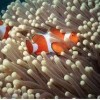The most quirky fish in reef aquariums, probably once owned by every aquarist is now known to be a boon to their host anemones. The popularity of clownfish is actually credited to their host relation with the anemones providing them protection and keeping intruders away from the anemones. The stinging tentacles of the anemones help keeping danger at bay from these clownfish who take shelter amidst them.
A recent US study on this bond between anemones and clownfish discovered that the anemones also benefit from the clownfish in more than one way. While clownfish move around, they boost up water flow over the anemone and increase its oxygen supply. The Journal of Experimental biology has published these findings.
This process is especially helpful for anemones during night when there is lesser oxygen supply as photosynthesis cease after sunset. But night is also when the main predators of clownfish hunt. Researchers found anemones hosting clownfish to use 1.4 times more oxygen, compared to anemones not hosting clownfish.
A rather more interesting fact is that clownfish with hosts were more likely to move around at night than those without a host, showing behavior defined as fanning, wedging and switching. “While many reef organisms can pick up and move to other areas with more oxygen, clownfish stick by their anemones; retreat is not an option,” explained Dr Joseph Szczebak from Auburn University, Alabama, US who led the study.
To understand more about the nocturnal relationship of the clownfish and anemone, Dr Szczebak and colleagues travelled to the Marine Science Station in Aqaba, Jordan and diving in the nearby Red Sea they found out how oxygen levels changed when the fish were in the anemones and when they were divided.
When clownfish rest in the tentacles of the host anemones, they are found to be more active and engaging in certain activities which were rarely or not seen while they lived alone. These activities are the reason why water movement is enhanced and more oxygen is made available.
“Anemone oxygen consumption increases with water flow, suggesting that any flow-related side effects of clownfish behaviour will indeed increase anemone breathing rates.”
The three activities noticed during the process were defined as follows:
“During fanning, clownfish were motionless among the tentacles, aside from rhythmically flapping their pectoral fins.”
“During wedging, the clownfish forcefully wiggle deeper into the anemone’s bed of tentacles, causing a flutter of tentacular activity.”
“Lastly, during switching, clownfish rapidly changed their orientation within the anemone.”
Earlier studies have proved that clownfish are usually passive during night to prevent from predators moving around. But this new study has proved the contrast to be somewhat truer. Their movement might be a risk to them as predators may get attracted by their waving of tentacles but this does not stop them from their active movement when they are in company of their host anemones.
“Yes, the level of activity that these fish engage in is sure to increase their oxygen demand; however, consider the alternative: if their anemone was to deflate or die due to a lack of oxygen, where would that leave the clown?”
The researchers are continuing to explore the relationship between the clownfish and their host anemone to understand if “aeration” is the only objective of the fish.
“This research joins a growing body of knowledge that is using the ecological and physiological connections of coral reef relationships to show just how highly evolved and interdependent coral reef systems are,” Dr Szczebak told news people.




